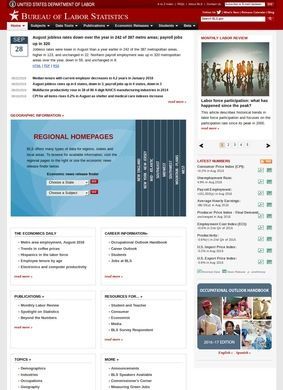The U.S. Bureau of Labor Statistics is an official entity of the United States government which comprehensively presents labor market data and statistics. It is governed under the domain of the United States Department of Labor. Its functions are accessible online through a .gov domain, serving as a guarantee of the site's legitimacy as an official federal government platform.
In striving to keep information secure, the site's use of HTTPS indicates that both connection and communication are encrypted and reliable. This is pivotal in ensuring that the data and information shared on the website are both encoded and transmitted securely.
The U.S. Bureau of Labor Statistics offers several essential services. It provides an updated Release Calendar and a dedicated Blog for additional insights. Users have the opportunity of delving deeper into the entity's history, its leadership roles, the framework for budget and performance, and even inquiries and responses for any potential questions. It also offers a comprehensive glossary for context clarification.
Moreover, there is a wide range of career opportunities within the U.S. Bureau of Labor Statistics, while the public has accessibility to obtain speakers for engagements from the BLS. Notably, the bureau also deals with occurrences of errors, thereby offering a dedicated Errata section for correction purposes.
A significant portion of the website is dedicated to providing a detailed overview of business operations, demographic breakdowns, industry specifics, business costs, occupations, and geography. This exhaustive data presentation makes it a rich resource for various stakeholders such as business leaders, consumers, developers, economists, investors, job seekers, media, researchers, students, teachers, and survey respondents.
Amongst many subjects, the U.S. Bureau of Labor Statistics presents significant research and data on inflation and prices, employment costs, wage data by occupation, earnings by demographics and industries, various county wages, strike and lockout data, and unemployment insurance. This data-driven approach fosters a clear understanding of labor market trends and movements, effectively serving the diverse needs of its significant audience-base.
In conclusion, the U.S. Bureau of Labor Statistics is a vital and trustworthy source of labor market data and analysis, effectively covering an extensive range of aspects related to the labor industry within the United States. It presents itself as an invaluable resource for different sections of the public, offering reliable and secure access to important labor market statistics and reports.
